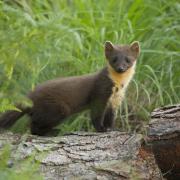When people think of rodents, the first feelings that spring to mind are often negative. For millennia, humans have lived alongside rodents but often viewed them as pests, due to their habit of raiding food and crop supplies. Yet some are loved and even kept as pets, recognised for their playful and intelligent characters.
Rodents are widely misunderstood. They vary greatly in behaviour and appearance. Some have confusing names, like the hazel dormouse, which isn’t a mouse at all. And brown rats were given the scientific name Rattus norvegicus, but they originated from Asia and not Norway.
We have 18 species of rodent in the UK, including voles, squirrels, dormice and true mice. The largest native rodent is the Eurasian beaver, which with a weight of up to 30kg is almost 20 times heavier than the red squirrel, our second-largest fully native rodent. Of those 18 species, four of them are mice: another widely misunderstood group of mammals.
Mice play a key role in the natural environment, from distributing plant seeds to being prey for animals like owls and foxes. When small rodent populations are low, the number of their predators falls dramatically too. Mice have short life spans in the wild, with an average of just one year. Population sizes can vary with weather conditions and food availability.
None of our true mice hibernate and must feed throughout the year, so there is potential to spot any of them at any time. But even though some mice are more common than others, they can all be hard to spot.

Harvest mouse
I’ll head straight to the smallest mouse and the UK’s smallest rodent. At around 10g, harvest mice are the weight of a 20p piece and so tiny that they are very rarely seen. With a body length of 7cm, chestnut fur and a long, twisty tail that is used to grip plant stems to help them climb, they are easily distinguished from other mice – if you are lucky enough to see one.
They tend to be associated with cereal crop fields, but are found in a variety of places. They like rough grasslands and reedbeds; or anywhere with plants offering long, tall stems, which are perfect for constructing their nests. Up to the size of a tennis ball, these nests are intricately woven onto plant stalks and lined with finer grasses, or anything else with good insulating properties.
Their nests are a key sign that they are present in an area; it is much easier to spot something the size of a tennis ball than a creature smaller than your thumb! Nest hunts are the best way to learn more about harvest mouse distribution in the UK.
Like other mice, they are attracted to seeds and grains. As a result, they occasionally show up unexpectedly around bird feeders during the winter, when natural seed sources are low. They are much more active in spring and summer, when they breed and build nests – but the chances of spotting one is always low!

House mouse
This mouse is synonymous with sharing buildings with humans. With lots of free food on offer and central heating, it is easy to see why.
House mice are usually around twice the weight of harvest mice and have a uniform grey/brown coat. They look similar to rats, but are much smaller and shyer, which is why many people with house mice raiding their pantries never actually spot the culprits. Although they can be found across most of the UK, they are less dominant than the next two mouse species. So in areas with high numbers of the next two species and low food supplies, house mice are often absent.

Wood Mouse
The name wood mouse is a misnomer as these adaptable mice will live anywhere. As long as they have safe cover and a good supply of food, they are quite happy. Like house mice, they will happily build nests in wall cavities, sheds and garages. But in a natural environment, they favour making nests in the bases of trees and shrubs. Around the same size as a house mouse, wood mice are more chestnut-brown and have very large eyes and prominent ears. They are found throughout the UK and are the mouse you’re most likely to spot.

Yellow-necked mouse
I’ve left the largest and feistiest UK mouse until last. I’ve had years of experience of trapping them as part of small mammal surveys. In my experience, it is safe to say that yellow-necked mice are the feistiest of our native mice. With teeth perfect for nibbling through hard nut shells and into fruit stones, they make light work of a human finger!
They are similar in appearance to wood mice, but they have a stand-out yellow/brown band across the front of their throat. They are also usually 1.5 times bigger than wood mice. Yellow-necks are associated with the native woodlands of Wales and the Marches, but have been found further east into the Midlands on small mammal surveys and sometimes living in people’s garages. Along with wood mice, they are attracted to peanuts and bird seeds, so can be easily lured in front of a camera trap to help monitor them. They are very territorial, particularly when food supplies are limited and are dominant over wood and house mice.

Did you know?
Voles are often mistaken for mice. Bank voles and common voles have smaller eyes (they are more active during the day), smaller ears and often scurry around, unlike mice, which are much bouncier.
Gardening - When the leaves start to fall in the coming months, don’t tidy too much
Over the next few weeks, leaves will start to change colour and fall from the trees, but don’t over-tidy them, as leaves play a huge role in the life cycles of many species.
Butterflies like the comma overwinter in dead leaves, and hedgehogs sometimes use leaf piles to hibernate through the winter. Detritivores such as woodlice feed on dead leaves and are really important in recycling the nutrients back into the soil, which is great for the plants in your garden!
If you need to clear some leaves, you could leave a designated patch untouched, create a leaf pile in a corner, or add them to a compost bin.



























